当前位置:首页 > Kinh doanh > Nhận định, soi kèo Enosis Neon Paralimni vs AEK Larnaca, 23h30 ngày 29/1: Khó tin chủ nhà 正文
标签:
责任编辑:Công nghệ

 Đề thi minh họa kỳ thi THPT Quốc gia năm 2017 của Bộ GD-ĐT môn Tiếng Pháp... Mời bạn đọc xem chi tiết.
Đề thi minh họa kỳ thi THPT Quốc gia năm 2017 của Bộ GD-ĐT môn Tiếng Pháp... Mời bạn đọc xem chi tiết.BỘ GIÁO DỤC VÀ ĐÀO TẠO
ĐỀ MINH HỌA
(Đề thi có 04 trang)
KỲ THI TRUNG HỌC PHỔ THÔNG QUỐC GIA NĂM 2017
Môn: TIẾNG PHÁP
Thời gian làm bài: 60 phút, không kể thời gian phát đề.
Chọn phương án đúng (ứng với A hoặc B, C, D) cho mỗi câu sau.
Câu 1:Les enfants jouent dans la cour, tout à coup ______ homme barbu apparaît.
A. tout B. un C. une D. chaque
Câu 2: De nos jours, les jeunes n’aiment pas habiter avec ______ parents.
A. nos B. vos C. leurs D. ses
Câu 3:J’aime le ______, j’en mange cinq fois par semaine.
A. viande B. glace C. poisson D. crème
Câu 4:Pour votre santé, offrez-vous ______ matin une boisson chaude, un laitage, deux tranches de pain grillé.
A. aucun B. tout C. un D. chaque
Câu 5:De tous les styles de musique, _____ que je préfère sont le rap et la danse.
A. ceux B. celui C. celles D. celle
Câu 6:Les étudiants n’ont toujours pas compris le texte, pourtant je ______ ai déjà expliqué plusieurs fois.
A. les leur B. le leur C. les y D. leur en
Câu 7:Prête-moi tes ciseaux, j’ai laissé ______ à la maison.
A. les miennes B. les tiennes C. les siens D. les miens
Câu 8:Cette région est très ______ : les gens sont sympathiques et les sites sont magnifiques.
A. déserte B. désert C. fréquentée D. fréquenté
Câu 9: Mon frère préfère les chemises ______.
A. bleu foncé B. bleus C. foncés D. bleu
Câu 10:Je suis retourné à la plage où nous nous ______.
A. serons rencontrés B. rencontrions C. rencontrerons D. étions rencontrés
Câu 11:L’île de Cat Ba offre toujours des vacances ______ aux touristes.
A. reposées B. reposant C. reposants D. reposantes
Câu 12: Ne quittez votre bureau qu’après ______ la lumière.
A. avoir éteint B. éteindre C. être éteinte D. être éteint
Câu 13:Je resterai ici jusqu’à ce que les résultats ______.
A. seront publiés B. seraient publiés C. soient publiés D. ont été publiés
Câu 14:Nous nous sommes ______ des messages pendant deux ans.
A. envoyé B. envoyés C. envoyée D. envoyées
Câu 15:______ sa mère est partie, le bébé n’a fait que pleurer.
A. Avant que B. Où que C. Depuis que D. Pour que
Câu 16:______ la gentillesse de son infirmière, le malade a repris courage.
A. À cause de B. En cas de C. Grâce à D. En dépit de
Câu 17: Tu bois trop de café ______ tu ne dormiras pas cette nuit.
A. à moins que B. chaque fois que C. du fait que D. si bien que
Câu 18:______ le métro serait bondé, je vous conseille de prendre le bus ou un taxi.
A. À condition que B. Au cas où C. À moins que D. À supposer que
Câu 19:Les gendarmes ont arrêté plusieurs manifestants. ______ a provoqué la colère du public.
A. Cette arrestation B. Cet arrêt C. Cet arrêté D. Cet arrêtoir
Câu 20:Cette rue est vraiment trop étroite. On cherche maintenant à la (l’) ______.
A. diminuer B. atténuer C. grandir D. agrandir
Câu 21:Ce garçon est toujours prêt à rendre service aux autres. Il est vraiment ______.
A. serviteur B. serviable C. un bon serveur D. servile
Câu 22:L’élevage des vaches se développe bien en Bretagne et l’industrie ______ connaît un grand succès.
A. laitée B. laiteuse C. laide D. laitière
Câu 23:Elisa n’a fait qu’une faute dans sa dictée. Le synonyme de “faute” est ______.
A. faiblesse B. erreur C. lacune D. trou
Câu 24: Les élèves en 6e apprennent à écrire des contes. Le synonyme de “écrire” est ______.
A. rédiger B. créer C. réciter D. raconter
Câu 25:Pendant le cours de mathématiques, mon groupe doit faire un problème très compliqué. Le verbe “faire” dans cette phrase signifie ______.
A. exercer B. pratiquer C. résoudre D. composer
Câu 26:– Où met-on ta valise ? – Tu pourrais la monter au deuxième ? L’antonyme de “monter” est ______.
A. démonter B. descendre C. détruire D. décoller
Câu 27:Son accueil a été très chaleureux. L’antonyme de “chaleureux” est ______.
A. froid B. chaud C. sensible D. hospitalier
Câu 28: La phrase “Le maire de la ville a invité les meilleurs étudiants à une réception.” correspond à ______.
A. Les meilleurs étudiants ont été invités à une réception par le maire de la ville
B. Les étudiants ont été invités par le maire à la meilleure réception de la ville
C. Le maire a organisé une réception pour inviter les meilleurs étudiants de la ville
D. Les meilleurs étudiants ont organisé une réception pour inviter le maire de la ville
Câu 29:La phrase “L’année prochaine, j’irai au Cambodge avec mes amis.” correspond à ______.
A. Ma fille m’a dit que l’année suivante, elle irait au Cambodge avec mes amis
B. Ma fille m’a dit que l’année suivante, elle irait au Cambodge avec ses amis
C. Ma fille m’a dit qu’elle allait au Cambodge avec ses amis l’année suivante
D. Ma fille m’a dit que l’année précédente, elle était allée au Cambodge avec ses amis
Câu 30:La phrase “Le député a été tellement éloquent qu’il a convaincu son auditoire.” correspond à ______.
A. Sans éloquence, le député a cependant convaincu son auditoire
B. Grâce à son éloquence, le député a convaincu son auditoire
C. Le député a convaincu son auditoire même avec son éloquence
D. Par manque d’éloquence, le député n’a pas convaincu son auditoire
Câu 31: Ce film est ennuyeux ______.
A. ainsi les jeunes l’adorent
B. c’est pourquoi il a eu la Palme d’or
C. mais il attire beaucoup de spectateurs
D. si bien qu’il apporte gros au producteur
Câu 32: L’avion décolle ______.
A. bien qu’il fasse du mauvais temps B. bien qu’il fasse du beau temps
C. en dépit du beau temps D. à cause du mauvais temps
Câu 33:“– Tu peux me prêter ton vélo ? – ______, j’en ai besoin pour une excursion.”
A. Je regrette B. Volontiers C. J’en ai assez D. Ça m’est égal
Câu 34:“– ______ ? – Désolé, je ne suis pas du quartier.”
A. La gare routière, SVP B. Vous avez l’heure
C. Vous faites quelle taille D. Vous désirez
Đọc bài khoá và chọn phương án đúng (ứng với A hoặc B, C, D) cho các câu từ 35 đến 42.
EN TAXI
J’appelle un taxi. Dans le taxi, Creezy serrée contre moi, je ______ (35) prends la main. Mais elle demande des choses au chauffeur, s’il est content de ______ (36) travail, ce qu’il fait pendant les heures creuses et si les embouteillages ne lui donnent pas de dépressions nerveuses. Le ______ (37) est enchanté. Il nous raconte qu’il est à son compte, qu’il ______ (38) en banlieue, qu’il élève des lapins. C’est affectueux, le lapin. Les siens le reconnaissent. À l’en croire, le lapin est un ______ (39) méconnu. Quant aux heures creuses, le chauffeur ne s’en plaint pas. Il lit. Des ouvrages ______ (40), de préférence. Pour l’instant, après Louis XIII, il en est à Louis XIV. Mais il n’a pas encore eu le temps ______ (41) se faire une idée du bonhomme. Honnêtement non, ce serait prématuré. Il se tourne vers moi : “Voyons, là, entre nous, monsieur, que ______ (42)-vous de ce monarque ?” Creezy est aux anges. À chaque détail, elle me donne un coup de genou ou sa main se crispe sur la mienne.
Félicien Marceau, Creezy, Gallimard, éd.
Câu 35:A. lui B. le C. leur D. les
Câu 36:A. votre B. son C. mon D. ton
Câu 37:A. patron B. véhicule C. touriste D. chauffeur
Câu 38:A. balade B. travaille C. habite D. s’amuse
Câu 39:A. animal B. insecte C. oiseau D. carnivore
Câu 40:A. économiques B. historiques C. scientifiques D. géographiques
Câu 41:A. de B. en C. par D. à
Câu 42:A. faites B. donnez C. pensez D. parlez
Đọc bài khoá và chọn phương án đúng (ứng với A hoặc B, C, D) cho các câu từ 43 đến 50.
JOURNÉE MONDIALE DE L’EAU
Les chiffres parlent d’eux-mêmes : 2 milliards et demi de personnes n’ont pas accès à l’eau potable. Et pourtant, l’eau saine, c’est la santé ! En France, l’eau potable coule dans les robinets, sans que nous nous posions trop de questions, mais dans de nombreux pays, l’accès à l’eau saine n’existe toujours pas.
Plus d’une personne sur six dans le monde n’a pas accès à la quantité minimale dont l’être humain a besoin chaque jour : entre 20 à 50 litres d’eau propre pour boire, manger et faire sa toilette. Dans les pays en développement, comme l’Inde par exemple, 90 % des eaux d’égout et 70 % des déchets industriels sont rejetés directement dans la nature. Résultat : pollution de l’environnement, l’eau des rivières souillée provoque des maladies mortelles. 1,5 million d’enfants de moins de 5 ans meurent chaque année pour avoir absorbé cette eau polluée.
Depuis une vingtaine d’années, les Nations Unies et de nombreuses associations ont gagné des combats pour l’accès à l’eau : aujourd’hui 85 % de l’humanité en bénéficie. En Chine et en Inde, 89 % de la population ont désormais accès à l’eau potable. De même pour les installations sanitaires, on est passé de 41 % à 55 % en Chine et de 18 % à 31 % en Inde.
Reste qu’en 2015, l’objectif que s’était fixé les Nations Unies, celui de réduire de moitié le nombre de personnes privées d’équipement sanitaire, ne sera peut-être pas atteint. Pourtant, tous sont d’accord pour dire qu’un meilleur accès à l’eau passe par la prévention ou par la mise en place de réseaux sanitaires qui permettent de traiter les eaux usées avant qu’elles ne retournent dans la nature.
23 mars 2010, par La rédac’
http://1jour1actu.com/planete/journee–mondiale–de–l2019eau/
Câu 43:Ce texte a été publié ______.
A. sur un site Internet B. dans un magazine
C. dans un journal D. dans une revue
Câu 44:Il s’agit d’un texte ______.
A. informatif B. narratif C. explicatif D. injonctif
Câu 45: Actuellement, 2 milliards et demi de personnes ______.
A. utilisent de l’eau potable B. n’ont pas d’eau potable
C. ont de l’eau potable D. produisent de l’eau potable
Câu 46:La France produit ______.
A. suffisamment d’eau potable B. peu d’eau potable
C. insuffisamment d’eau potable D. trop d’eau potable
Câu 47:En Inde, 90 % des eaux d’égout ne sont pas ______.
A. polluées B. rejetées C. traitées D. utilisées
Câu 48:Dans les pays en développement, l’eau des rivières ______.
A. est polluée par les activités humaines B. est protégée par les activités humaines
C. est souillée par des maladies mortelles D. empêche le traitement des maladies mortelles
Câu 49:L’objectif des Nations Unies est de réduire le nombre de personnes qui ______.
A. ont accès aux installations sanitaires B. utilisent les installations sanitaires
C. disposent des installations sanitaires D. n’ont pas accès aux installations sanitaires
Câu 50:La mise en place de réseaux de santé permet ______.
A. de prévenir le traitement des eaux usées
B. d’augmenter le nombre de personnes utilisant de l’eau potable
C. de se passer du traitement des eaux usées
D. de se passer d’un meilleur accès à l’eau potable
-----------HẾT----------
BAN GIÁO DỤC
Công bố đề thi minh họa kỳ thi THPT quốc gia 2017
Bộ GD-ĐT đã công bố đề thi minh họa của 14 môn thi của kỳ thi THPT quốc gia 2017.
" alt="Đề thi minh họa môn Tiếng Pháp kỳ thi THPT Quốc gia năm 2017"/>Đề thi minh họa môn Tiếng Pháp kỳ thi THPT Quốc gia năm 2017
Hoa hậu Hà Kiều Anh đọ sắc cùng Anh Thư trên ghế giám khảo
Ngoài đời Phương Oanh 'Quỳnh búp bê' đẹp gấp nhiều lần trên phim
 |
| Nam diễn viên kiêm ca sĩ Trần Chí Bằng mới đây gây chú ý khi "vồ ếch" trên sân khấu trong một buổi biểu diễn thời trang trong khuôn khổ của "Tuần lễ thời trang Bắc Kinh 2018". |
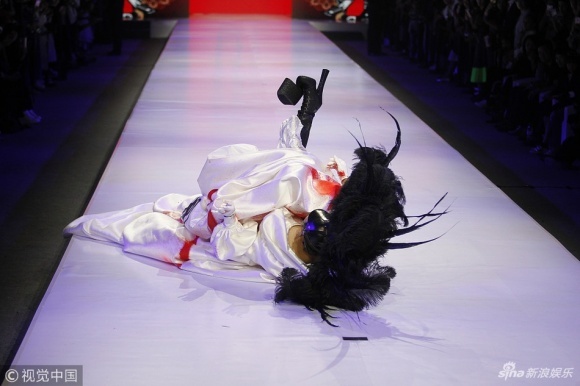 |
| Xuất hiện với trang phục đầm bồng bềnh, “Nhĩ Thái” của “Hoàn Châu Cách Cách” còn đi giày cao gót khủng. Đó chính là nguyên nhân khiến anh ngã đau trên sân khấu. |
 |
| Sau khi gặp sự cố, Trần Chí Bằng đã bình tĩnh xử lý tình huống. |
 |
| Thậm chí, nam diễn viên còn tranh thủ tạo dáng sau khi ngã sấp mặt. |
 |
| Phong thái bình tình xử lý tình huống phát sinh trên sân khấu đáng khen của Trần Chí Bằng. |
 |
| Nam diễn viên thậm chí cởi giày đi chân trần để tiếp tục phần trình diễn. Anh được biết đến với vai trò diễn viên, đạo diễn kiêm nhà sản xuất điện ảnh. Tuy nhiên, thời trang mới là niềm đam mê lớn nhất với anh. Anh thay đổi phong cách, không ngại trang điểm hay làm tóc ấn tượng trong những buổi diễn thời trang. |
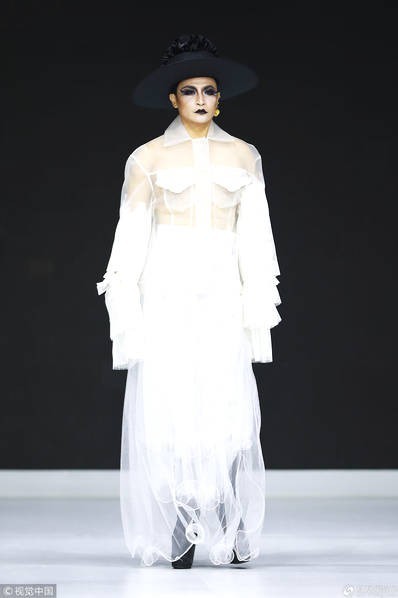 |
| Sinh năm 1971, Trần Chí Bằng là ca sĩ kiêm diễn viên tại Trung Quốc. Anh từng nổi tiếng với vai trò là thành viên nhóm nhạc “Little Tigers” và tham gia bộ phim “Hoàn Châu Cách Cách” với vai diễn Nhĩ Thái. |
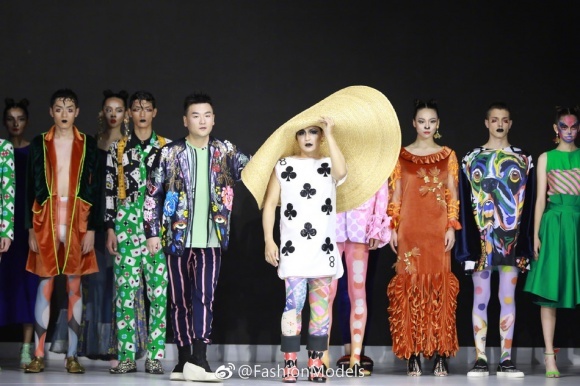 |
| Trần Chí Bằng từng có thời gian học về thời trang tại Mỹ. Kể từ khi đó, anh thay đổi phong cách thời trang. Anh cho biết thời trang là niềm đam mê lớn của mình và không ngại bị chê là lố lăng hay chiêu trò |
Băng Tâm

Gia đình cùng hàng xóm xung quanh đã đến chúc mừng Hoa hậu Trần Tiểu Vy khi cô trở về quê nhà Hội An (Quảng Nam) sau đăng quang ngôi vị Hoa hậu Việt Nam 2018.
" alt="'Nhĩ Thái' Trần Chí Bằng 'vồ ếch' vì mặc váy, đi giày cao gót"/>'Nhĩ Thái' Trần Chí Bằng 'vồ ếch' vì mặc váy, đi giày cao gót
Sáng 24/10, hội thảo “Định hướng triển khai và lộ trình phát triển ngân hàng câu hỏi cho kỳ thi chung tiến tới thi Chứng chỉ hành nghề cho Bác sĩ đa khoa (BSĐK)” đã diễn ra với sự tham gia của Ban Tuyên giáo Trung ương, Văn phòng Chính phủ, các Bộ Giáo dục và Đào tạo, Bộ Y tế, Ngân hàng Thế giới, Tổ chức Y tế thế giới, đại diện các cơ sở giáo dục đào tạo ngành y và các bệnh viện lớn trên toàn quốc.
Hội thảo đã đưa ra các vấn đề cần thảo luận để tiến tới thực hiện kỳ thi tốt nghiệp quốc gia cho BSĐK trong tương lai: mục đích của kỳ thi, đối tượng tham gia, cấu trúc đề thi, nội dung đề thi, kế hoạch xây dựng ngân hàng câu hỏi, ban soạn thảo đề thi… Các đại biểu tham dự hội thảo được chia thành 4 nhóm để thảo luận, đưa ra câu trả lời cho những vấn đề cụ thể. Có nhiều vấn đề nhận được sự nhất trí cao của các thành viên, tuy nhiên vẫn còn những vấn đề cần tiếp tục được bàn thảo trong những hội thảo tiếp theo.
Mở đầu hội thảo, đại diện tới từ Viện Chiến lược và chính sách Y tế - Bộ Y tế đã trình bày tổng quan về thi chứng chỉ hành nghề ở các quốc gia trên thế giới. Khách mời là GS. Gordon Strewler (ĐH California, Mỹ) cũng trình bày lộ trình xây dựng một kỳ thi quốc gia dành cho BSĐK. Lộ trình tóm lược mà ông đưa ra như sau:
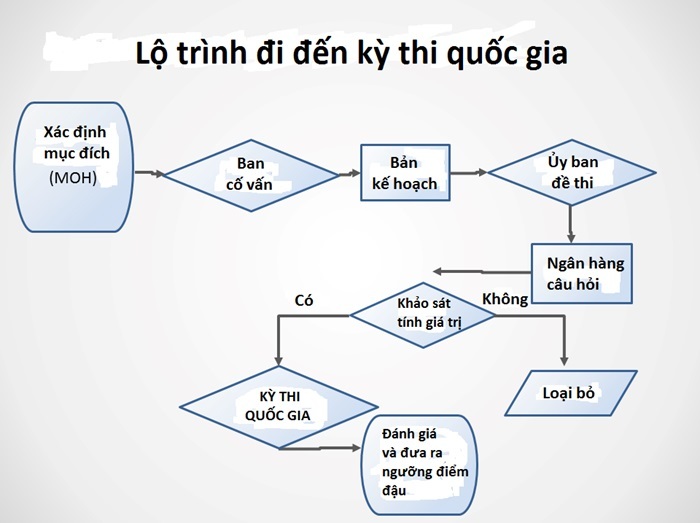 |
Sửa Luật, yêu cầu Chứng chỉ hành nghề
Phần thảo luận của nhóm 1 - gồm các cơ quan tham gia xây dựng chính sách – nhất trí đưa ra 3 mục đích của kỳ thi quốc gia: đảm bảo mục tiêu nâng cao chất lượng dịch vụ y tế thông qua nâng cao chất lượng nguồn nhân lực y tế, xác định chuẩn năng lực nghề nghiệp tối thiểu của cán bộ y tế khi tham gia hệ thống y tế.
Tuy nhiên, nhóm này đề xuất thay đổi đối tượng tham gia kỳ thi: không phải chỉ dành cho BSĐK, mà dành cho đối tượng nhân viên y tế nói chung, gồm: bác sĩ điều dưỡng, kỹ thuật viên, hộ sinh…
Nhóm 1 cũng thống nhất ý kiến, kỳ thi quốc gia sẽ là kỳ thi cấp chứng chỉ hành nghề và chứng chỉ hành nghề này sẽ được yêu cầu cho các hoạt động chuyên môn. Hiện nay, quy định về chứng chỉ hành nghề do Luật khám bệnh, chữa bệnh quy định. Cho nên, đại diện của nhóm đề nghị sắp tới phải khẩn trương sửa Luật khám bệnh, chữa bệnh để việc thi quốc gia cấp chứng chỉ hành nghề được quy định trong Luật.
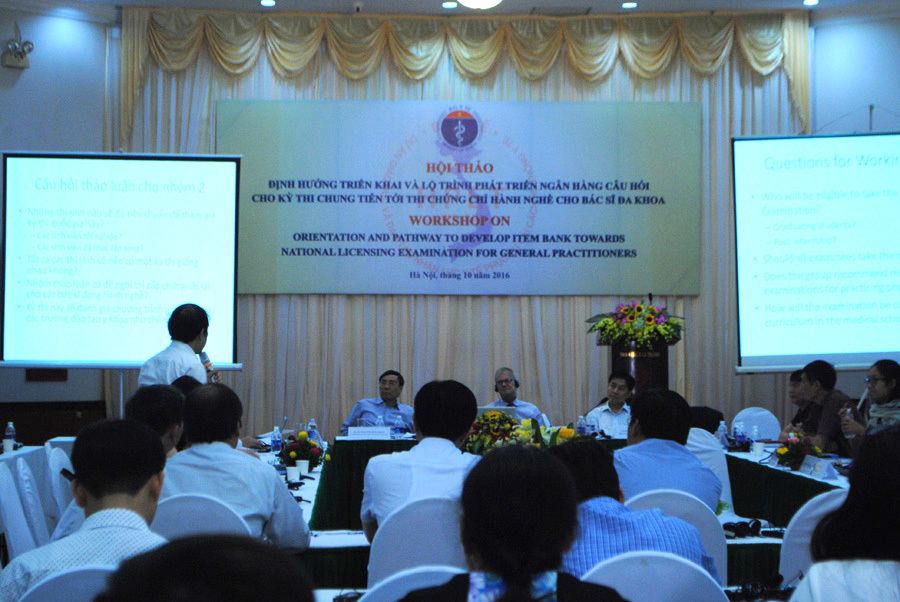 |
| Hội thảo diễn ra với sự tham gia của đại diện các Bộ, Cục, các trường đại học và bệnh viện lớn trên cả nước |
Chủ đề thảo luận của nhóm 2 được đặt ra cho đại diện các Trường ĐH Y Hà Nội, ĐH Y khoa Phạm Ngọc Thạch, ĐH Y dược TP.HCM, khoa Dược ĐH Quốc gia Hà Nội, ĐH Y dược Thái Nguyên, Bệnh viện Chợ Rẫy và một số trường cao đẳng y tế.
Đa số thành viên nhóm này đồng ý kỳ thi sẽ được tổ chức cho các sinh viên đã hoàn thành 6 năm y khoa, trước khi bước vào 18 tháng thực hành. Đại diện nhóm đưa ra lý do cho quyết định này: “Thi sau tốt nghiệp sẽ giải quyết được nhiều vấn đề, phù hợp với xu hướng chung và định hướng 6 +3 (6 năm đa khoa + 3 năm chuyên khoa) sắp tới của chúng ta”.
Nhóm này cũng cho rằng, nếu kỳ thi được làm tốt sẽ là cơ sở để đánh giá chất lượng đào tạo của các trường. Dựa vào đó, các trường cũng điều chỉnh chương trình đào tạo, đánh giá sinh viên để phù hợp với kỳ thi. Ngoài ra, nhóm không đề nghị thi cấp chứng chỉ lại cho các bác sĩ đang hành nghề.
Một thành viên trong nhóm cũng khẳng định, cần làm rõ để tránh nhầm lẫn vấn đề sau: Đây là kỳ thi cấp chứng chỉ hành nghề dành cho sinh viên đã tốt nghiệp, có thể trước hoặc sau 18 tháng thực hành nhưng chưa học 3 năm chuyên khoa, nên đây có thể coi là chứng chỉ hành nghề tạm thời, được phép thực hành trên người bệnh, chứ chưa thể là chứng chỉ hành nghề mãi mãi ở một lĩnh vực chuyên khoa. Theo ông, sinh viên tốt nghiệp 6 năm y khoa “mới chỉ học kiến thức cơ bản, kể cả sau 18 tháng thực hành cũng mới chỉ là cơ bản. Nếu chứng chỉ hành nghề này là mãi mãi sẽ đi ngược lại với xu hướng chung của thế giới”.
Góp ý về vấn đề này, một đại biểu đề nghị đại diện các trường và bệnh viện hết sức lưu ý việc tập trung vào chứng chỉ hành nghề chuyên khoa. Đại biểu này cho rằng, mặc dù đồng ý với mô hình 6+3 cung cấp bác sĩ chuyên khoa cho hệ thống cơ sở y tế trung ương, song ông rất e ngại về việc hệ thống y tế cơ sở (tuyến xã, huyện, tỉnh) sẽ không có đủ nhân lực nếu thống nhất rằng sau khi hoàn thành 6 năm y khoa hay sau 18 tháng thực hành mà vẫn chưa đủ để hành nghề.
Trắc nghiệm lý thuyết, thực hành ở trung tâm
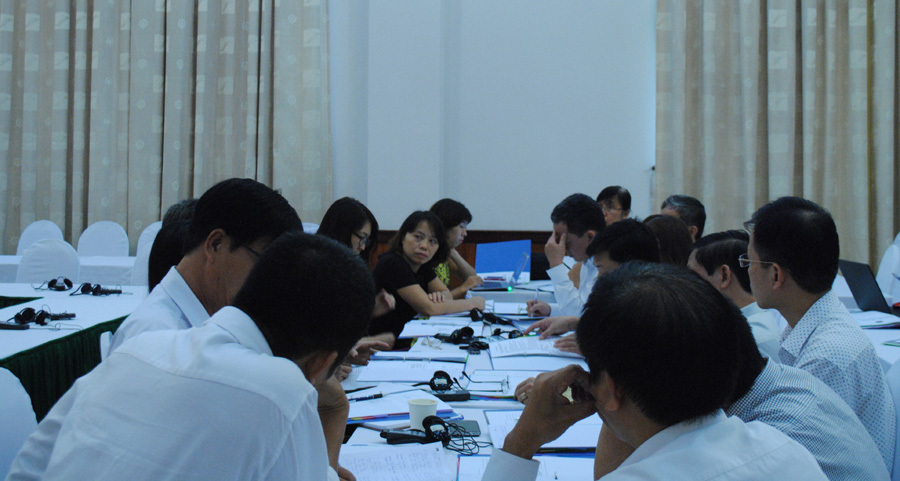 |
| Mỗi nhóm thảo luận về những vấn đề khác nhau để tiến tới thực hiện kỳ thi quốc gi cấp chứng chỉ hành nghề cho bác sĩ đa khoa |
Về nội dung kỳ thi, các thành viên nhóm 3 đề xuất 3 môn chính: kiến thức cơ sở, y tế công cộng, thực hành lâm sàng. Trong đó, thực hành lâm sàng sẽ chiếm tỷ trọng cao nhất và các chuyên môn trước mắt là: nội, ngoại, sản, nhi… cộng thêm các chuyên khoa khác.
Về cấu trúc đề thi, đối với phần thi lý thuyết sẽ thi theo hình thức trắc nghiệm trên máy tính. Nếu có điều kiện, sau này sẽ tổ chức thi online. Ở phần thực hành, các đại biểu đề xuất thi tại các trung tâm do Bộ Y tế giao. Cả nước phải có ít nhất 3-5 trung tâm, đảm bảo điều kiện thi tương đối giống nhau.
Các trường Y sẽ không trực tiếp tổ chức thi, mà Bộ Y tế sẽ giao cho các trung tâm tổ chức thi. Các trường chỉ được mời tham gia một phần nào đó.
Về các thành viên của Ủy ban đề thi (soạn thảo câu hỏi), các đại biểu nhóm 4 cho rằng nên lựa chọn thành viên bao gồm cả các bộ phận quản lý và bộ phận chuyên môn. Bộ phận quản lý gồm các Bộ, Cục liên quan. Thành viên chuyên môn là các chuyên gia tới từ các trường đào tạo, các bệnh viện lớn.
Nhóm này cũng đề xuất có sự tham gia của các chuyên gia trong lĩnh vực khảo thí, kiểm định chất lượng để đánh giá về độ khó dễ của đề thi, tính giá trị…
100% đại diện các trường cũng thống nhất sẽ xây dựng bộ câu hỏi hoàn toàn mới, chứ không dựa trên đề thi của các trường đào tạo y khoa. Tuy nhiên, Ủy ban đề thi nên tham khảo bộ câu hỏi của các trường và các trường nên đề xuất bộ câu hỏi cho ban đề thi tham khảo. Ngoài ra, Ủy ban cũng nên tham khảo bộ đề thi của các nước trên thế giới để bắt kịp xu hướng.
Sinh viên Y khoa sẽ phải thi chứng chỉ hành nghề sau khi tốt nghiệp

Nhận định, soi kèo Becamex Bình Dương vs Hà Nội FC, 18h00 ngày 19/4: Tin vào cửa trên
 |
Chia sẻ với PV VietNamNet, ông Thọ cho rằng nhiều người đang hiểu sai về hệ thống đào tạo trường chuyên khi lấy một vài điển hình xấu để đưa ra cái nhìn tổng thể. “Những trường chuyên đào tạo ra học sinh giỏi, nhưng giỏi không phải chỉ một môn mà giỏi toàn diện. Bởi những học sinh đã giỏi thì cái gì các em cũng muốn tìm hiểu. Cơ bản là trường có định hướng học sinh đáp ứng yêu cầu hay không mà thôi”, ông Thọ nêu quan điểm.
Ông Thọ chia sẻ: “Có thể thấy không phải vô cớ mà những cuộc thi trí tuệ, kiến thức toàn diện cho học sinh THPT như Đường lên đỉnh Olympia, hầu hết các thí sinh vào chung kết đều đến từ các trường chuyên”.
Theo ông Thọ, ngoài việc đào tạo mũi nhọn, các trường chuyên cũng rất chú trọng hướng tới việc đào tạo học sinh phát triển toàn diện. Dẫn chứng ngay ở Trường THPT Chuyên Lê Hồng Phong, điều này thể hiện rõ nhất ở việc trường hiện quan tâm nhất đến việc đào tạo ngoại ngữ cho học sinh, một điểm được xác định là điểm yếu của các học sinh tỉnh lẻ.
“Tiếc là các học sinh trường chuyên đặc biệt ở các địa phương như chúng tôi thì ngoại ngữ còn kém. Có tình trạng là các em đúng là học sinh giỏi, thậm chí tốt nghiệp vào ngoại thương, kinh tế,… những trường top đầu của Việt Nam nhưng ra trường vẫn thất nghiệp”.
Do đó, trường xác định hướng cần khắc phục là nâng cao năng lực ngoại ngữ của học sinh. Để làm được điều này, 3 năm nay, trường này liên kết hợp tác với một số trung tâm tiếng Anh. Một mặt tập trung vào việc đào tạo, bồi dưỡng giáo viên tiếng Anh và giáo viên dạy các bộ môn khoa học tự nhiên bằng tiếng Anh. Mặt khác tăng cường các giờ học với giáo viên bản ngữ.
“Chương trình giáo viên Việt và nước ngoài sẽ được đồng bộ vào với nhau. Giáo viên nước ngoài mạnh về khả năng nghe nói thì dạy về cái đó. Giáo viên Việt tập trung dạy về ngữ pháp và viết luận cho học sinh”.
Cũng vì vậy mà theo ông Thọ, nhiều năm trở lại đây khả năng tiếng anh học sinh đã có những tiến bộ vượt trội. “Năm trước điểm ngoại ngữ bình quân thi THPT quốc gia của học sinh trường trên 7, năm vừa rồi là trên 6,5. Đến thời điểm này, số lượng học sinh của trường giỏi ngoại ngữ là tương đối đông”.
 |
Ông Vũ Đức Thọ, Hiệu trưởng Trường THPT Chuyên Lê Hồng Phong, Nam Định. |
Ông Thọ cho rằng, để có thể phát triển được hệ thống trường chuyên, khâu quan trọng nhất vẫn là giáo viên. “Tăng cường bồi dưỡng giáo viên là khâu quan trọng nhất, có thể nói làm tốt khâu đào tạo giáo viên thì kết quả chất lượng sẽ lên. Đây là một trong số những hoạt động quan trọng nhất cần phải làm”.
Theo ông Thọ, lực lượng giáo viên trẻ kế cận là rất cần thiết bởi lực lượng cao tuổi hoặc sắp nghỉ hưu hoặc đến độ tuổi không chịu được áp lực dạy chuyên. “Chúng tôi định hướng thay đổi đội ngũ kế cận. Vì vậy phải xây dựng được một khung chương trình đồng bộ để đội trẻ sẽ dựa vào khung chương trình đấy để biết phải dạy cái gì, làm được gì thì sẽ thực hiện được tốt. Nếu không, có thể người ta có thể rất giỏi, nhiệt huyết nhưng không biết nên làm theo hướng nào. Việc xây dựng chương trình khung là để phục vụ trực tiếp cho đối tượng bổ sung vào đội ngũ chuyên.
Dựa trên khung chương trình chung, trường cũng có thể yêu cầu tất cả các giáo viên hiện có tự viết bài giảng và trong vài năm sẽ có hệ thống bài giảng riêng phục vụ trực tiếp cho công tác giảng dạy của trường. “Ngoài ra, để nâng cao chất lượng, chúng tôi yêu cầu bắt buộc hàng năm giáo viên phải có đề tài nghiên cứu. Việc này để đánh giá khả năng tự học và tự nghiên cứu của từng giáo viên”.
Cần có cơ chế động viên học sinh giỏi
Cũng xác định giáo viên chính là yếu tố tiên quyết đến việc thành công của hệ thống đào tạo chuyên, bà Đỗ Thị Hòa, Hiệu trưởng Trường THPT Chuyên Trần Phú (Hải Phòng) lo lắng hiện thiếu nguồn tuyển mới.
 |
Bà Đỗ Thị Hòa, Hiệu trưởng Trường THPT Chuyên Trần Phú, Hải Phòng. |
“Giờ có ai vào sư phạm đâu, thậm chí trong những em đội tuyển tham dự thi học sinh giỏi chỉ đếm trên đầu ngón tay số vào ngành sư phạm. Nếu có thì chủ yếu là các môn thuộc khoa học xã hội. Còn khoa học tự nhiên thì rất ít các em bước vào ngành sư phạm để trở thành các thầy cô”. Bà Hòa thực sự lo lắng bởi tính chất của hệ chuyên đòi hỏi các thầy cô phải có nền tảng đào tạo rất tốt. “Hiện nay trường chúng tôi có 3 thầy giáo chuyên Toán và đang rất muốn tuyển thêm một sinh viên giỏi. Nhưng 2 năm nay không có một hồ sơ nào. Ngành sư phạm giờ dư rất nhiều, nhưng thật sự xuất sắc, đáp ứng được yêu cầu, có tố chất, tiềm năng dạy chuyên thì với các bộ môn khoa học tự nhiên không phải nhiều”, bà Hòa nêu thực tế.
Ngoài ra, theo bà Hòa, để có thể khuyến khích được công tác đào tạo chuyên, cần có cơ chế đặc biệt cho những học sinh giỏi. Cụ thể, Bộ GD-ĐT cần xây dựng một cơ chế động viên đối với học sinh giỏi quốc gia. “Mỗi năm, mỗi trường chuyên chỉ có một đội tuyển thi học sinh giỏi quốc gia từ 8-10 em ở mỗi bộ môn. Những học sinh này phải mất từ 11-12 năm phấn đấu, rèn luyện để trở thành thành viên của đội tuyển tham dự thi học sinh giỏi quốc gia. Nhưng theo cơ chế thì chỉ khoảng 50% số này có giải. Trong đó có cả giải Khuyến khích, thế nhưng diện tuyển thẳng cũng chỉ từ giải Ba trở lên. Rõ ràng số lượng được ưu tiên này rất hạn chế bởi tính tổng mỗi tỉnh cũng chỉ khoảng 100 em. Số có giải thì không nói, nhưng số còn lại thì như chỉ tham gia một cuộc chơi mà không được một quyền lợi gì. Trong khi, để được trở thành người chơi của cuộc chơi đó phải đầu tư nhiều công sức, đâu phải là ăn may. Chưa kể, khi không đạt giải, quay về ôn thi đại học, có khi các em lại đuối hơn so với các bạn không dành nhiều tâm huyết cho việc vào được đội tuyển”, bà Hòa nói.
Điều này dẫn đến nảy sinh thực tế nhiều trường chuyên mà ngay Trường THPT chuyên Trần Phú, nhiều bộ môn rất khó khăn trong việc động viên học sinh tham dự đội tuyển học sinh giỏi quốc gia. Đây là cái khó trong việc đào tạo và phát triển các trường chuyên.
Bà Hòa cũng đề xuất cần phải có sự động viên, cơ chế khích lệ hợp lý với bất kỳ học sinh nào vào được đội tuyển thi học sinh giỏi quốc gia của địa phương đó. Có thể là có một chứng nhận và phải được cộng điểm thi đại học môn học đó khi học sinh tham gia thi đại học.
“Như vậy các em học sinh giỏi khi bước vào đội tuyển đã cảm thấy có được một vinh dự. Và tại sao với học sinh giỏi, chúng ta lại khắt khe đến thế?, bà Hòa nói.
 - Đề thi minh họa kỳ thi THPT quốc gia năm 2017 của Bộ GD-ĐT môn tiếng Anh. Mời bạn đọc xem chi tiết.
- Đề thi minh họa kỳ thi THPT quốc gia năm 2017 của Bộ GD-ĐT môn tiếng Anh. Mời bạn đọc xem chi tiết.BỘ GIÁO DỤC VÀ ĐÀO TẠO
ĐỀ MINH HỌA
(Đề thi có 05 trang)
KỲ THI TRUNG HỌC PHỔ THÔNG QUỐC GIA NĂM 2017
Môn: TIẾNG ANH
Thời gian làm bài: 60 phút, không kể thời gian phát đề
Mark the letter A, B, C, or D on your answer sheet to indicate the word whose underlined part differs from the other three in pronunciation in each of the following questions.
Question 1:A. wanted B. stopped C. decided D. hated
Question 2:A. century B. culture C. secure D. applicant
Mark the letter A, B, C, or D on your answer sheet to indicate the word that differs from the other three in the position of primary stress in each of the following questions.
Question 3:A. offer B. canoe C. country D. standard
Question 4:A. pollution B. computer C. currency D. allowance
 |
Mark the letter A, B, C, or D on your answer sheet to indicate the correct answer to each of the following questions.
Question 8: I haven‘t met him again since we ______ school ten years ago.
A. have left B. leave C. left D. had left
Question 9:A recent survey has shown that ______ increasing number of men are willing to share the housework with their wives.
A. a B. an C. the D. some
Question 10:The more demanding the job is, ______ I like it.
A. more B. most C. the more D. the most
Question 11:John wanted to know ______ in my family.
A. there were how many people B. how many people were there
C. were there how many people D. how many people there were
Question 12:Richard, my neighbor, _______ in World War II.
A. says to fight B. says to have fought C. is said to fight D. is said to have fought
Question 13: Students are ______ less pressure as a result of changes in testing procedures.
A. under B. above C. upon D. out of
Question 14: Tom is getting ever keener on doing research on ______.
A. biology B. biological C. biologist D. biologically
Question 15: Many people and organizations have been making every possible effort in order to save ______ species.
A. endangered B. dangerous C. fearful D. threatening
Question 16:A number of young teachers nowadays ______ themselves to teaching disadvantaged children.
A. offer B. stick C. give D. devote
Question 17:Whistling or clapping hands to get someone‘s attention is considered ______ and even rude in some circumstances.
A. suitable B. unnecessary C. appropriate D. impolite
Question 18:―Sorry for being late. I was ______ in the traffic for more than an hour.‖
A. carried on B. held up C. put off D. taken after
Question 19:She was tired and couldn‘t keep ______ the group.
A. up with B. up against C. on to D. out of
Mark the letter A, B, C, or D on your answer sheet to indicate the most suitable response to complete each of the following exchanges.
Question 20: Two friends Diana and Anne are talking about Anne‘s new blouse.
- Diana: ―That blouse suits you perfectly, Anne.‖
- Anne: ―______‖
A. Never mind. B. Don‘t mention it. C. Thank you. D. You‘re welcome.
Question 21:Mary is talking to a porter in the hotel lobby.
- Porter: ―Shall I help you with your suitcase?‖
- Mary: ―______‖
A. Not a chance. B. That‘s very kind of you.
C. I can‘t agree more. D. What a pity!
Mark the letter A, B, C, or D on your answer sheet to indicate the word(s) CLOSEST in meaning to the underlined word(s) in each of the following questions.
Question 22:Students are expected to always adhere to school regulations.
A. question B. violate C. disregard D. follow
Question 23:A number of programs have been initiated to provide food and shelter for the underprivileged in the remote areas of the country.
A. rich citizens B. active members C. poor inhabitants D. enthusiastic people
Mark the letter A, B, C, or D on your answer sheet to indicate the word(s) OPPOSITE in meaning to the underlined word(s) in each of the following questions.
Question 24:Drivers are advised to get enough petrol because filling stations are few and far between on the highway.
A. easy to find B. difficult to access C. unlikely to happen D. impossible to reach
Question 25:We managed to get to school in time despite the heavy rain.
A. earlier than a particular moment B. later than expected
C. early enough to do something D. as long as expected
Mark the letter A, B, C, or D on your answer sheet to indicate the sentence that is closest in meaning to each of the following questions.
Question 26:I‘m sure Luisa was very disappointed when she failed the exam.
A. Luisa must be very disappointed when she failed the exam.
B. Luisa must have been very disappointed when she failed the exam.
C. Luisa may be very disappointed when she failed the exam.
D. Luisa could have been very disappointed when she failed the exam.
Question 27: ―You had better see a doctor if the sore throat does not clear up,‖ she said to me.
A. She reminded me of seeing a doctor if the sore throat did not clear up.
B. She ordered me to see a doctor if the sore throat did not clear up.
C. She insisted that I see a doctor unless the sore throat did not clear up.
D. She suggested that I see a doctor if the sore throat did not clear up.
Question 28:Without her teacher‘s advice, she would never have written such a good essay.
A. Her teacher advised him and she didn‘t write a good essay.
B. Her teacher didn‘t advise her and she didn‘t write a good essay.
C. She wrote a good essay as her teacher gave her some advice.
D. If her teacher didn‘t advise her, she wouldn‘t write such a good essay.
Mark the letter A, B, C, or D on your answer sheet to indicate the sentence that best combines each pair of sentences in the following questions.
Question 29:She tried very hard to pass the driving test. She could hardly pass it.
A. Although she didn‘t try hard to pass the driving test, she could pass it.
B. Despite being able to pass the driving test, she didn‘t pass it.
C. No matter how hard she tried, she could hardly pass the driving test.
D. She tried very hard, so she passed the driving test satisfactorily.
Question 30: We didn‘t want to spend a lot of money. We stayed in a cheap hotel.
A. Rather than spending a lot of money, we stayed in a cheap hotel.
B. In spite of spending a lot of money, we stayed in a cheap hotel.
C. We stayed in a cheap hotel, but we had to spend a lot of money.
D. We didn‘t stay in a cheap hotel as we had a lot of money to spend.
Read the following passage and mark the letter A, B, C, or D on your answer sheet to indicate the correct word or phrase that best fits each of the numbered blanks from 31 to 35.
WAYS TO IMPROVE YOUR MEMORY
A good memory is often seen as something that comes naturally, and a bad memory as something that cannot be changed, but actually (31)______ is a lot that you can do to improve your memory.
We all remember the things we are interested in and forget the ones that bore us. This no doubt explains the reason (32)______ schoolboys remember football results effortlessly but struggle with dates from their history lessons! Take an active interest in what you want to remember, and focus on it (33)______. One way to ̳make‘ yourself more interested is to ask questions — the more the better!
Physical exercise is also important for your memory, because it increases your heart (34)______ and sends more oxygen to your brain, and that makes your memory work better. Exercise also reduces stress, which is very bad for the memory.
The old saying that ―eating fish makes you brainy‖ may be true after all. Scientists have discovered that the fats (35)______ in fish like tuna, sardines and salmon — as well as in olive oil — help to improve the memory.
Vitamin-rich fruits such as oranges, strawberries and red grapes are all good ̳brain food‘, too.
(Source: ―New Cutting Edge‖, Cunningham, S. & Moor. 2010. Harlow: Longman)
Question 31: A. there B. it C. that D. this
Question 32: A. why B. what C. how D. which
Question 33:A. hardly B. slightly C. consciously D. easily
Question 34:A. degree B. level C. rate D. grade
Question 35: A. made B. existed C. founded D. found
Read the following passage and mark the letter A, B, C, or D on your answer sheet to indicate the correct answer to each of the questions from 36 to 42.
It used to be that people would drink coffee or tea in the morning to pick them up and get them going for the day. Then cola drinks hit the market. With lots of caffeine and sugar, these beverages soon became the pick-me-up of choice for many adults and teenagers. Now drink companies are putting out so-called "energy drinks." These beverages have the specific aim of giving tired consumers more energy.
One example of a popular energy drink is Red Bull. The company that puts out this beverage has stated in interviews that Red Bull is not a thirst quencher. Nor is it meant to be a fluid replacement drink for athletes.
Instead, the beverage is meant to revitalize a tired consumer's body and mind. In order to do this, the makers of Red Bull, and other energy drinks, typically add vitamins and certain chemicals to their beverages. The added chemicals are like chemicals that the body naturally produces for energy. The vitamins, chemicals, caffeine, and sugar found in these beverages all seem like a sure bet to give a person energy.
Health professionals are not so sure, though. For one thing, there is not enough evidence to show that all of the vitamins added to energy drinks actually raise a person's energy level. Another problem is that there are so many things in the beverages. Nobody knows for sure how all of the ingredients in energy drinks work together.
Dr. Brent Bauer, one of the directors at the Mayo Clinic in the US, cautions people about believing all the claims energy drinks make. He says, ―It is plausible if you put all these things together, you will get a good result.‖ However, Dr. Bauer adds the mix of ingredients could also have a negative impact on the body. ―We just don't know at this point,‖ he says.
(Source: ―Reading Challenge 2‖, Casey Malarcher & Andrea Janzen, Compass Publishing)
Question 36:The beverages mentioned in the first paragraph aim to give consumers ______.
A. caffeine B. sugar C. more energy D. more choices
Question 37:The word “it” in the second paragraph refers to ______.
A. one example B. the company C. Red Bull C. thirst quencher
Question 38:According to the passage, what makes it difficult for researchers to know if an energy drink gives people energy?
A. Natural chemicals in a person‘s body B. The average age of the consumer
C. The number of beverage makers D. The mixture of various ingredients
Question 39: The word ―plausible‖ in the passage is closest in meaning to _______.
A. impossible B. reasonable C. typical D. unlikely
Question 40: What has Dr. Bauer probably researched?
A. Countries where Red Bull is popular B. Energy drinks for teenage athletes
C. Habits of healthy and unhealthy adults D. Vitamins and chemicals in the body
Question 41:Which of the following is NOT true according to the passage?
A. Bauer does not seem to believe the claims of energy drink makers.
B. Colas have been on the market longer than energy drinks.
C. It has been scientifically proved that energy drinks work.
D. The makers of Red Bull say that it can revitalize a person.
Question 42:What is the main idea of this passage?
A. Caffeine is bad for people to drink. B. It is uncertain whether energy drinks are healthy.
C. Red Bull is the best energy drink. D. Teenagers should not choose energy drinks.
Read the following passage and mark the letter A, B, C, or D on your answer sheet to indicate the correct answer to each of the questions from 43 to 50.
What is ̳extreme‘ weather? Why are people talking about it these days? ̳Extreme‘ weather is an unusual weather event such as rainfall, a drought or a heat wave in the wrong place or at the wrong time. In theory, they are very rare. But these days, our TV screens are constantly showing such extreme weather events. Take just three news stories from 2010: 28 centimetres of rain fell on Rio de Janeiro in 24 hours, Nashville, USA, had 33 centimetres of rain in two days and there was record rainfall in Pakistan.
The effects of this kind of rainfall are dramatic and lethal. In Rio de Janeiro, landslides followed, burying hundreds of people. In Pakistan, the floods affected 20 million people. Meanwhile, other parts of the world suffer devastating droughts. Australia, Russia and East Africa have been hit in the last ten years. And then there are unexpected heat waves, such as in 2003 in Europe. That summer, 35,000 deaths were said to be heat-related.
So, what is happening to our weather? Are these extreme events part of a natural cycle? Or are they caused by human activity and its effects on the Earth‘s climate? Peter Miller says it‘s probably a mixture of both of these things. On the one hand, the most important influences on weather events are natural cycles in the climate. Two of the most famous weather cycles, El Niño and La Niña, originate in the Pacific Ocean. The heat from the warm ocean rises high into the atmosphere and affects weather all around the world. On the other hand, the temperature of the Earth‘s oceans is slowly but steadily going up. And this is a result of human activity. We are producing greenhouse gases that trap heat in the Earth‘s atmosphere. This heat warms up the atmosphere, land and oceans. Warmer oceans produce more water vapour – think of heating a pan of water in your kitchen. Turn up the heat, it produces steam more quickly. Satellite data tells us that the water vapour in the atmosphere has gone up by four percent in 25 years. This warm, wet air turns into the rain, storms, hurricanes and typhoons that we are increasingly experiencing. Climate scientist, Michael Oppenheimer, says that we need to face the reality of climate change. And we also need to act now to save lives and money in the future.
(Source: © 2015 National Geographic Learning.www.ngllife.com/wild-weather)
Question 43:It is stated in the passage that extreme weather is ______.
A. becoming more common B. not a natural occurrence
C. difficult for scientists to understand D. killing more people than ever before
Question 44: The word ―lethal‖ in the second paragraph probably means ______.
A. far-reaching B. long-lasting C. happening soon D. causing deaths
Question 45: What caused thousands of deaths in 2003?
A. a period of hot weather B. floods after a bad summer
C. a long spell of heavy rain D. large-scale landslides
Question 46: According to the passage, extreme weather is a problem because ______.
A. we can never predict it B. it only affects crowded places
C. it‘s often very destructive D. its causes are completely unknown
Question 47:The word ―that‖ in the third paragraph refers to ______.
A. Earth‘s oceans B. human activity C. greenhouse gases D. Earth‘s atmosphere
Question 48: Extreme weather can be caused by ______.
A. satellites above the Earth B. water vapour in the atmosphere
C. very hot summers D. water pans in your kitchen
Question 49: Satellites are used to ______.
A. change the direction of severe storms
B. trap greenhouse gases in the atmosphere
C. measure changes in atmospheric water vapour
D. prevent climate from changing quickly
Question 50: Which statement is NOT supported by the information in the passage?
A. Extreme weather is substantially influenced by human activity.
B. Unusual weather events are part of natural cycles.
C. We can limit the bad effects of extreme weather.
D. Such extreme weather is hardly the consequence of human activity.
________THE END_________

Công bố đề thi minh họa kỳ thi THPT quốc gia 2017
Bộ GD-ĐT đã công bố đề thi minh họa của 14 môn thi của kỳ thi THPT quốc gia 2017.
" alt="Đề thi minh họa môn tiếng Anh kỳ thi THPT quốc gia 2017"/>
Lễ cưới của Son Ye Jin và Hyun Bin là sự kiện giải trí được quan tâm ngày 31/3 ở Châu Á. Đám cưới của hai ngôi được tổ chức ngoài trời tại Aston House, Grand Walkerhill, Gwangjin-gu, Seoul. Trong đám cưới, Son Ye Jin bật khóc trong đám cưới, nắm chặt tay bố khi bước vào lễ đường.
|
| Cô rơi nước mắt vì xúc động. Thời khắc quan trọng nhất, Hyun Bin trao nhẫn và hứa luôn ở bên cô suốt đời. |